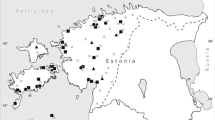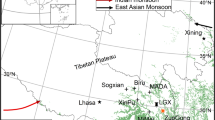Abstract
The understanding of historic hydroclimatic variability is basic for planning proper management of limited water resources in northeastern Mexico. The objective of this study was to develop a network of tree-ring chronologies to reconstruct hydroclimate variability in northeastern Mexico and to analyze the influence of large-scale circulation patterns, such as ENSO. Precipitation sensitive tree-ring chronologies of Douglas-fir were developed in mountain ranges of the Sierra Madre Oriental and used to produce winter-spring precipitation reconstructions for central and southern Nuevo Leon, and southeastern Coahuila. The seasonal winter-spring precipitation reconstructions are 342 years long (1659–2001) for Saltillo, Coahuila and 602 years long (1400–2002) for central and southern Nuevo Leon. Both reconstructions show droughts in the 1810s, 1870s, 1890s, 1910s, and 1970s, and wet periods in the 1770s, 1930s, 1960s, and 1980s. Prior to 1800s the reconstructions are less similar. The impact of ENSO in northeastern Mexico (as measured by the Tropical Rainfall Index) indicated long-term instability of the Pacific equatorial teleconnection. Atmospheric circulation systems coming from higher latitudes (cold fronts or `nortes’) and others developed in the Gulf of Mexico (tropical storms, hurricanes) also influence the climatic conditions characterizing this region. The recent development of new and longer tree-ring chronologies for the region will contribute to a better understanding of the interannual and multidecadal climatic variability of northeastern Mexico.
Similar content being viewed by others
References
Acosta GV, Perez Z JM, and Molina del Villar A (2003) Desatres agrícolas en Mexico. Catalogo historico I. Epoca prehispanica y colonial(958–1822. FCE, CIESAS. Mexico. 506 pp
Acuna-Soto R, Stahle DW, Cleaveland MK, and Therrell MD (2002) Megadrought and megadeath in 16th century Mexico. Emerging InfectiousDiseases 8(4):360–362
Allanch WC, and Johnson-Richards B (1995) Water infrastructure study Saltillo, Mexico, in Charbeneau RJ, (editor), Ground WaterManagement, Proceedings, First International Conference on Water Resources Engineering, American Society of Civil Engineers, New York, pp. 18–23
Cleaveland MK, Stahle DW, Therrell MD, Villanueva-Diaz J, and Burns BT (2003) Tree-ring reconstructed winter precipitation and tropicalteleconnections in Durango, Mexico. Climatic Change 59:369–388
Comisión Nacional del Agua (2002) Estaciones climáticas para Coahuila. Sistema Meteorólogico Nacional. Saltillo, Coahuila. México
Comisión Nacional del Agua. (2005) Estadísticas del agua en México. SEMARNAT-CNA. México DF,
Cook ER, and Peters K (1981) The smoothing spline: a new approach to standardizing forest interior tree-ring width series for dendroclimaticstudies. Tree-Ring Bulletin 41:45–53
Cook ER (1987) The decomposition of tree-ring series for environmental studies. Tree-Ring Bulletin 47:37–59
Cook, Edward R, Meko, DM, Stahle DW, and Cleaveland MK (1999) Drought reconstructions for the continental United States. American Meteorological Society 12:1145–1162
Conde C, Liverman D, Flores M, Ferrer M, Araújo R, Betancourt E, Villareal G, and Gay C, (1997) Vulnerability of rainfed maizecrops in Mexico to climate change. Climate Research 9:17–23
Cuellar Valdéz PM (1979) Historia del estado de Coahuila. Vol. 1. Saltillo, Coahuila. 180 pp
Díaz-Castro S, Therrell MD, Stahle DW, and Cleaveland MK (2002) Chihuahua winter-spring precipitation reconstructed from tree-rings,1647–1992. Climate Research 22:237–244
Douglas MW, Maddox RA, Howard K, and Reyes S (1993) The Mexican Monsoon. American Meteorological Society (6):1665–1677
Escobar Ohmstede A (1997) Las sequías y sus impactos en las sociedades del México decimonónico, 1856–1900. En García-Acosta V,(coordinadora), ‘ Historia y desastres en América Latina', Volumen II. Red de Estudios Sociales en Prevención de Desastres en América LatinaMéxico, pp. 2–32.
Florescano E (1980) Análisis histórico de las sequías en México. Secretaría de Agricultura y Recursos Hidráulicos,Comisión del Plan Nacional Hidráulico. México DF,
Fritts HC (1976) Tree rings and climate. Academic Press, New York. 567 pp
Fritts HC (1991) Reconstructing large-scale climatic patterns from tree-ring data: a diagnostic analysis. The University of Arizona Press, Tucson&London. 286 pp
Fye, Falko K, Stahle DW, and Cook ER (2003) Paleoclimatic analogs to twentieth-century moisture regimes across the United States. Bulletin ofthe American Meteorological Society 84(7):901–909
Garcia Acosta V (1993) Las sequías históricas de México. Desastres y Sociedad 1(1):1–18
García Acosta V, Perez Zevallos JM, Molina del Villar A (2003) Desastres agrícolas en México. Catalogo histórico 1. Epocaprehispanica y colonial (958–1822). FCE, CIESAS. Mexico DF,
García Hernández A (1997) Alternativas ante las sequías de 1789–1810 en la villa de Saltillo, Coahuila, México. EnGarcía-Acosta V, (coodinadora). Historia y desastres en América Latina, Vol. II. Red de Estudios Sociales en América Latina. 148–169
González Elizondo M (2003) Indicadores de cambio climático en algunas especies de pinaceas de la Sierra Madre Occidental, México. TesisDoctoral. Manejo de Recursos Naturales. Facultadad de Ciencias Forestales. Universidad Autónoma de Nuevo León. Linares, Nuevo León. 193 p
González-Elizondo M, Jurado E, Navar J, González-Elizondo MS, Villanueva J, Aguirre O, and Jiménez J (2005) Tree-rings andclimate relationships for Douglas-fir chronologies from the Sierra Madre Occidental, Mexico: A 1681-2001 rain reconstruction. Forest Ecology and Management 213:39–53
Grissino-Mayer HD (2001) Evaluating crossdating accuracy: a manual and tutorial for the computer program COFECHA. Tree-Ring Research 57(2):205–221
Higgins RW, Chen Y, and Douglas AV, 1999, Interannual variability of the North America warm season precipitation regime. Journal of Climate 12(3):653–680
Holmes RL (1983) Computer-assisted quality control in tree-ring dating and measurement. Tree-Ring Bulletin 43:69–78
Instituto Mexicano de Estadística, Geografía é Informática (INEGI). 1983, Síntesis geográfica de Coahuila, México. 165pp
Instituto Mexicano de Tecnología del Agua (IMTA) (1997) Banco Nacional de Datos de Aguas Superficiales (BANDAS). Período 1921–1994Software. Jiutepec, Morelos, México
Kohler MA (1949) On the use of double-mass analysis for testing the consistency of meteorological records and for making required adjustmentsBulletin of the American Meteorological Society 82:96–97
Magaña V, Perez JL, Vazquez JL, Carrizosa E, y Perez J (1999) ‘El Niño y el clima'. En Magaña V. (editor). Los impactos delNiño en México. SEP-CONACYT. Mexico DF, 23–68
McDonald JA (1993) ‘Phytogeography and history of the alpine-subalpine flora of northeastern Mexico', in Ramamoorthy TP, Bye R, Lot A, andFa J, (eds.), Biologial Diversity of Mexico: Origins and Distribution, Oxford University Press, New York, pp. 681–1697
Mosiño PA, and Garcia E (1974) The climate of Mexico. In Bryson RA; Hare FK, Eds. The Climates of Northamerica. Word survey ofclimatology Elsevier Sci. New York. 11:345–404
Ott L (1988) An introduction to statistical methods and data analysis, third edition. PWS-KENT Publishing Company
Paulhus JL, H, and Kohler MA (1952) Interpolation of missing precipitation records. Monthly Weather Review 80(8):1165–1173
Pike CB (1972) Some meteorological aspects of the seasonal distribution of precipitation in the western United States and Baja California.University of California Water Resources Center. Davis, Calif
Pohl, Kelly, Therrell MD, Blaly JS, Ayotte N, Cabrera-Hernandez JG, Diaz-Castro C, Cornejo-Oviedo EH, Elvir JA, Gonzalez-Elizondo,M., Opland D, Park J, Pederson G, Bernal-Salazar S, Vasquez-Selem L, Villanueva-Diaz J, Stahle DW (2003) A cool season precipitation reconstructionfor Saltillo, Mexico. Tree-Ring Research 59(1):11–19
Revenga CJ, Brunner N, Henninger K, Kassen R, Pyne. (2000) Pilot analysis of global ecosystems: fresh water systems. World Resources Institute,Washington DC, 65 pp
Ropelewski CF, and Halpert MS (1986) North American precipitation and temperature patterns associated with El Niño/Southern Oscillation(ENSO). Monthly Weather Review 114:2352–2362
Snedecor GW, and Cochran WG (1989) Statistical methods, eight edition, Iowa State University Press, Ames
Stahle DW, and Cleaveland MK (1993) Southern Oscillation estremes reconstructed from tree rings of the Sierra Madre Occidental and SouthernGreat Plains. Journal of Climate 6:129–140
Stahle DW, D'Arrigo RD, Krusic PJ, Cleaveland MK, Cook ER, Allan RJ, Cole JE, Dunbar RB, Therrell MD, Gay DA, Moore MD, Stokes MA, Burns BT, Villanueva-Diaz J, and Thompson LG (1998) Experimental dendroclimatic reconstruction of the Southern Oscillation. Bulletin ofthe American Meteorological Society 79(10): 2137–2152
Stahle DW, Cook ER, Cleaveland MK, Therrell MD, Meko DM, Grissino-Mayer H, Watson E, and Luckman BH (2000) Tree-ring datadocument 16th century megadrought over North America. Eos, Transactions, American Geophysical Union 81(12):121–125
Stokes MA, and Smiley TL (1968) An introduction to tree-ring dating. The University of Chicago. 73 pp
Therrell MD, Stahle DW, Cleaveland MK, and Villanueva-Diaz J (2002) Warm season tree growth and precipitation over Mexico. Journal ofGeophysical Research 107 (D14):6-1–6-8
Therrell MD, Stahle DW, and Acuña-Soto R (2004) Aztec drought and the curse of one rabbit. American Meteorological Society 85(9):1263–1272
Villanueva Díaz J, and McPherson GR (1999) Estudios dendroclimáticos en montañas del suroeste de los Estados Unidos de América ynorte de México. Ciencia Forestal en México 24(86):37–62 (In Spanish)
Therrell MD (2005) Tree rings and ‘El año del hambre' in Mexico. Dendrocronologia 22:203–207
Villanueva DJ, Luckman BH, Stahle DW, Therrell MD, Cleaveland MK, Cerano-Paredes J, Gutierrez-Garcia G, Estrada-Avalos J, andJasso-Ibarra R (2005) Hydroclimatic variability of the upper Nazas basin: water management implications for the irrigated area of the Comarca Lagunera.Dendrocronologia 22(3):215–223
Wright PB (1979) Persistance of rainfall anomalies in the Central Pacific. Nature 277:371–374
Author information
Authors and Affiliations
Corresponding author
Rights and permissions
About this article
Cite this article
Villanueva-Diaz, J., Stahle, D.W., Luckman, B.H. et al. Winter-spring precipitation reconstructions from tree rings for northeast Mexico. Climatic Change 83, 117–131 (2007). https://doi.org/10.1007/s10584-006-9144-0
Received:
Revised:
Accepted:
Published:
Issue Date:
DOI: https://doi.org/10.1007/s10584-006-9144-0




